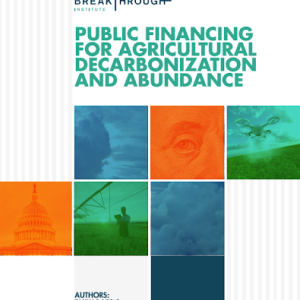
This report by the Breakthrough Institute argues for a more interventionist approach to decarbonising the food system by the US government, making up for the shortfall in private investment. In order for new food and agricultural innovations to provide climate benefits, the federal government must invest, the report says.
Publisher’s summary
In recent years, startups, university researchers, and government laboratories have developed a suite of new technologies capable of revolutionizing agriculture. From electric, autonomous tractors leveraging soil, plant, and satellite data to manufacturing processes that can produce real animal meat grown from a cell and green fertilizers that can increase crop productivity without the need to burn vast amounts of natural gas, innovation underpins the future of agriculture and food. These technologies have the potential to remake our food system for the better by minimizing greenhouse gas emissions, reducing land use, and avoiding animal slaughter, all while continuing to help produce more food.
But these and the many other novel innovations required to decarbonize agriculture are used in only a small fraction of agricultural production today. Bringing these technologies up to scale will require an embrace of public financing and other industrial policies for agriculture.
The Inflation Reduction Act of 2022 (IRA), arguably the most significant piece of climate legislation in U.S. history, appropriated billions of dollars to research, develop, and subsequently fund the deployment of technologies capable of reducing greenhouse gas (GHG) emissions from U.S. and global economic production. But, IRA funding — like much of the climate-focused federal spending in recent years — has centered on energy production, transportation, and infrastructure. While agriculture has received little focus in decarbonization policy, the sector has made strides in improving its environmental footprint.
Over the past half-century, American farmers have increased agricultural yields while reducing the per-unit emissions of many agricultural products. Agricultural productivity growth has made the U.S. the largest agricultural exporter in the world, exporting nearly $180 billion in agricultural products in 2021 — more than three times the value of U.S. automotive exports in the same year.
But for the United States to achieve decarbonization across its industries, agricultural emissions will need to be diminished further. Agriculture is responsible for 10% of U.S. greenhouse gas emissions and about 25% of the global total. Agriculture is also the single largest user of land in the United States and a major source of air and water pollution. And still, the U.S. has one of the most productive agricultural sectors in the world.
Despite the necessity of new food and agricultural technologies to achieve decarbonization, private sector finance has not been able or willing to fund and build the industries and technologies required to decarbonize the food system. This is not surprising. With some exceptions, private investors are often risk-averse — especially when providing large amounts of funding — and are obligated to seek positive returns. The technologies capable of reducing agricultural emissions while maintaining productivity — electric tractors, alternative proteins, controlled environment agriculture, novel fertilizers, feed additives to reduce methane production in cattle, and much more — all have high potential, but are by no means sure bets.
Ignoring food and farming innovation does not bode well for both decarbonization and the ability of farmers to continue to produce abundant food. During the 2019-2020 fiscal year, agrifood systems received 28.5 billion of project-level climate finance. Agriculture, specifically, received $11.9 billion per year in project-level climate finance and about $2.1 billion per year in venture capital investments globally, a tiny portion of the estimated need of $30 billion to $218 billion per year to achieve agricultural decarbonization.
This report makes the case for a far more interventionist innovation approach by USDA.
Creating the right policy mixture for the broader challenge of agricultural decarbonization will require understanding the specific problems plaguing firms and technological solutions. Programs aimed at funding the construction of first-of-a-kind facilities, new loan programs designed for agricultural and food technologies and specific tax credits for investments in and production of those technologies are just a few examples of specific solutions to the financing challenges facing emerging industries today.
For agricultural technologies to come to market and provide the climate benefits required to decarbonize agriculture, the federal government will need to invest. Robust funding programs aimed at research, commercial demonstration, and deployment can unlock the crucial technologies needed to accelerate decarbonization and underpin continued agricultural productivity growth.
Reference
E.Bass & A.Smith. (2024) Public financing for agriculture decarbonization and abundance. Breakthrough Institute.
Read more here. See the TABLE explainer, What is regenerative agriculture?












Post a new comment »